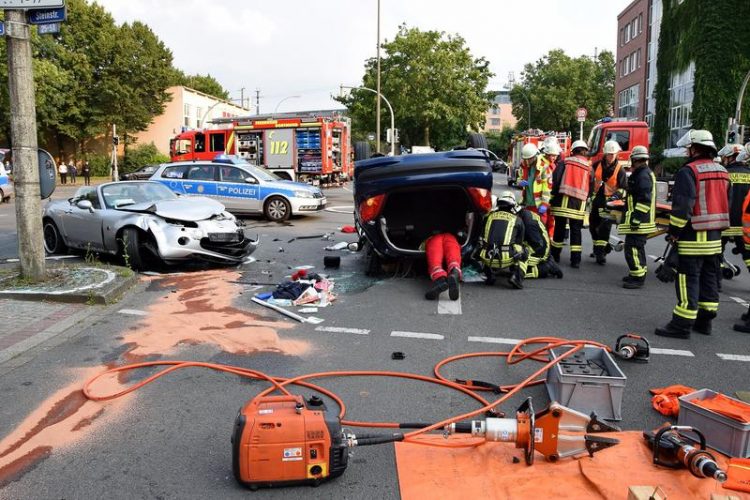Laser rescue system for serious accidents

Conventional rescue systems more and more often reach their limits with modern materials. Photo: Stadt Dortmund – Institut für Feuerwehr- und Rettungstechnologie
In the past 25 years, the number of road traffic deaths has been drastically reduced, and the number of severely injured persons decreased significantly, too. Among others, the declining figures are due to improved passive safety. The use of high-tensile steel and composite materials adds to this.
Time as a decisive factor
The higher vehicle stability achieved by using these materials, however, becomes a problem in the event of an accident. Because the available rescue systems, such as power, plasma or hydraulic rescue cutters require a lot of time to cut the car body, or they even fail in individual cases. Time, however, is crucial during a rescue mission. The faster a person is freed, the higher the chances to survive.
Using the laser at the accident site
This is where the project comes in: A compact laser unit shall be developed that can be used when conventional rescue tools reach their limits. With this system it shall be possible to cut modern materials in a short time, or to broach them so that they can be cut faster with conventional tools.
Moreover, it shall be investigated within the scope of the project how the safe use of the laser at the accident site can be guaranteed. Here, it is also being checked, for example, which shut-off devices are required for the system. In addition, the scientists evaluate which measures must be taken to protect the rescue team, the accident victim and uninvolved third parties. This includes curtains, mats and protection glasses.
Diversified consortium
The partners from many different sectors ensure that all relevant aspects are considered. Project partners of the LZH are: Coherent (Deutschland) GmbH, SGE Spezialgeräteentwicklung GmbH, WEBER-HYDRAULIK GmbH, eifeler Lasertechnik GmbH, LASERVISION GmbH & Co. KG and Stadt Dortmund – Institut für Feuerwehr- und Rettungstechnologie.
Associated project partners are: Bundesanstalt für Arbeitsschutz und -medizin, Berufsgenossenschaft Energie Textil Elektro Medienerzeugnisse, DB Fahrzeuginstandhaltung GmbH, DEKRA Automobil GmbH, GuS – Präzision in Kunststoff, Glas und Optik GmbH & Co. KG, Bundesanstalt Technisches Hilfswerk, Unfallkasse NRW and Volkswagen AG.
The project is being sponsored by the German Federal Ministry of Education and Research (BMBF) within the scope of the program “Civil safety – innovative rescue and safety systems” until October 2019.
Media Contact
More Information:
http://www.lzh.de/All latest news from the category: Transportation and Logistics
This field deals with all spatial and time-related activities involved in bridging the gap between goods and people, including their restructuring. This begins with the supplier and follows each stage of the operational value chain to product delivery and concludes with product disposal and recycling.
innovations-report provides informative reports and articles on such topics as traffic telematics, toll collection, traffic management systems, route planning, high-speed rail (Transrapid), traffic infrastructures, air safety, transport technologies, transport logistics, production logistics and mobility.
Newest articles

Largest magnetic anisotropy of a molecule measured at BESSY II
At the Berlin synchrotron radiation source BESSY II, the largest magnetic anisotropy of a single molecule ever measured experimentally has been determined. The larger this anisotropy is, the better a…

Breaking boundaries: Researchers isolate quantum coherence in classical light systems
LSU quantum researchers uncover hidden quantum behaviors within classical light, which could make quantum technologies robust. Understanding the boundary between classical and quantum physics has long been a central question…

MRI-first strategy for prostate cancer detection proves to be safe
Active monitoring is a sufficiently safe option when prostate MRI findings are negative. There are several strategies for the early detection of prostate cancer. The first step is often a…



